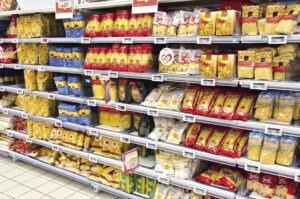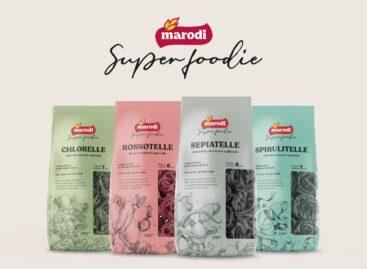Flour, eggs…and a pinch of creativity
This article is available for reading in Trade magazin 2025/6-7.
Stagnating prices and stabilising pasta sales – 2024 was like this, according to market players, but they add that this price level can’t be maintained this year, as last year the wheat harvest wasn’t particularly good and the price of high-quality wheat started to increase significantly at the end of autumn.
Long-term factors

Gábor Bokros
marketing director
Gyermelyi
“Consumers are shopping more cautiously and the contents of their shopping baskets are shrinking. Nevertheless, the Gyermelyi brand has performed better than private label products: our brand growth has exceeded the market average by far”,
says Gábor Bokros, marketing director of Gyermelyi Zrt.

Csaba Mándy Jr
owner-managing director
Mary-Ker Pasta
More and more shoppers are looking for higher quality, more nutritious products, such as durum wheat pasta or egg alternatives, says Csaba Mándy Jr, owner and managing director of Mary-ker Pasta Kft.
“In addition to health consciousness, there is also a focus on sustainability, as more people are interested in products in environmentally friendly packaging”,
he adds.

Pasta sales stabilised last year, but there could be another price rise this year
They look at the price – and other things too

Róbert Rácz
sales and
marketing director
Izsáki Házitészta
In Izsák they think the most intense trend at the moment is that consumers are open to cheaper products.
“First-price products and private labels are gaining ground against branded pastas. Consumption has shifted in the direction of smaller formats and products with lower egg content”,
says Róbert Rácz, sales and marketing director of Izsáki Házitészta Kft. Consumers’ buying decisions are increasingly determined by complex factors

Tamás Bozó
sales manager
GOF Hungary
“This phenomenon isn’t only about increased price-sensitivity, but also about consumers consciously searching for solutions that offer them important parameters (e.g. gluten-free, quick preparation, vegan options) within a given budget”,
underlines Tamás Bozó, sales manager of GOF Hungary Kft.
Traditional Hungarian, youthful Italian

Brigitta Soós
sales and
quality assurance manager
Soós Tészta
Brigitta Soós, sales and quality assurance manager of Soós Tészta Kft. believes that this year will also be full of challenges. Because of the wheat situation, the first difficulty will be sourcing flour of the right quality and quantity.
“We have been working with our supplier partner for several decades, so we can consider ourselves lucky that we “only” have to worry about prices”,
she explains.
In her opinion the market remains rather conservative when it comes to pasta, so the company is still committed to making products that form the basis of traditional Hungarian cuisine. At the same time quick and simple Italian-style recipes are becoming popular among younger consumers, so satisfying their needs is also important.

The most striking change in consumer preferences is the growing interest in healthier choices
Niche products growing on strong foundations
Gyermelyi Zrt. continues to realise the majority of sales from its traditional premium Gyermelyi pasta made with fresh eggs. Sales of the Vita Pasta durum product range have also strengthened, while sales of low-egg or egg-free pasta have declined. Although they are only niche products, the company has been able to increase sales of its wholemeal Integrale durum pasta, which is increasingly popular internationally. They rolled out a new product range last fall: Gyermelyi Express pasta is unique because it can be prepared in just 3 minutes.
Sustainability and artisan type products
Mary-ker Pasta Kft. continues to develop its premium pastas and pays special attention to meeting the demand for health-conscious and sustainable products. In their innovation work one of our most important goals is sustainability, and they make sure that sales results are achieved not by shrinkflation, but via real steps taken to curb the company’s environmental impact. Environmentally friendly packaging, using raw materials from controlled sources and recycled materials, plus energy-efficient manufacturing processes have been given a key role. They also emphasise the artisanal nature of premium products and plan to launch specially shaped pastas that improve the eating experience.

Due to the relatively conservative taste of consumers, traditional Hungarian formats are the mainstays of the range
Special shapes for the Hungarian market
Izsáki Házitészta Kft. is constantly renewing and updating its product selection. They recommend the Izsáki 4-egg small flower pasta for light spring and summer soups and salads. The company has added Izsáki pappardelle to the portfolio, a quick-to-prepare product with a youthful look. They also have a really special product, Izsáki Magyar pasta. This high-quality, 4-egg pasta in a 300g pack is the perfect choice for those looking for homemade flavours and premium ingredients in a special form: the pack contains pasta shapes symbolising Hungarian culture, such as a wine bottle, the castle of Gyula, the Parliament building, a pálinka glass, Hungarian paprika, etc.

For premium brands, competition is intensifying, making it increasingly important to communicate the differences between brands
Premium gluten-free products
GOF Kft. has built a stable premium position with its gluten-free, oat-containing products. They are planning significant developments in the pasta category this year. Due to climate change and weather challenges, the company has already started working on a new alternative ingredient that has a similarly high nutritional value as oat and is gluten-free. GOF Kft. is receiving an increasing number of requests from retail chains to produce private label gluten-free products for them, not only in the lower price range but also in premium quality. //
Italian dominance among pasta shapes
According to YouGov Shopper’s measurements, nearly all Hungarian households purchase the pasta category in a year, with an average of 9kg per year. Based on data from the past three years, we typically buy pasta once a month, occasionally slightly more than 750g. Owing to the high inflation experienced in 2022-2023, the average price per kilogram increased by around 80% vs. 2021. However, the price was down 5% in 2024 and as a result a household spent nearly HUF 11,000 on pasta. Hungarian households typically prefer pasta made with eggs, which accounts for more than two-thirds of purchases; durum pasta realises more than a fifth of volume sales. According to type and shape, the most popular pasta products are spaghetti/macaroni and square/”csusza” pasta, with the former purchased by two-thirds of households and the latter by nearly 60% in a year. More than two-thirds of the pasta bought is a private label product. //
Related news
We took you on a flight! (Part 2)
🎧 Hallgasd a cikket: Lejátszás Szünet Folytatás Leállítás Nyelv: Auto…
Read more >Brand Footprint – the celebration of brands
🎧 Hallgasd a cikket: Lejátszás Szünet Folytatás Leállítás Nyelv: Auto…
Read more >Marodi Superfoodie Tagliatelle pastas
🎧 Hallgasd a cikket: Lejátszás Szünet Folytatás Leállítás Nyelv: Auto…
Read more >Related news
THE LATEST ISSUE OF TRADE MAGAZINE HAS BEEN PUBLISHED!
🎧 Hallgasd a cikket: Lejátszás Szünet Folytatás Leállítás Nyelv: Auto…
Read more >Agroinform.hu: Three-quarters of fir tree buyers can decorate their homes with products from domestic producers again this year
🎧 Hallgasd a cikket: Lejátszás Szünet Folytatás Leállítás Nyelv: Auto…
Read more >István Nagy: the total output value and profitability of agriculture have also increased
🎧 Hallgasd a cikket: Lejátszás Szünet Folytatás Leállítás Nyelv: Auto…
Read more >






